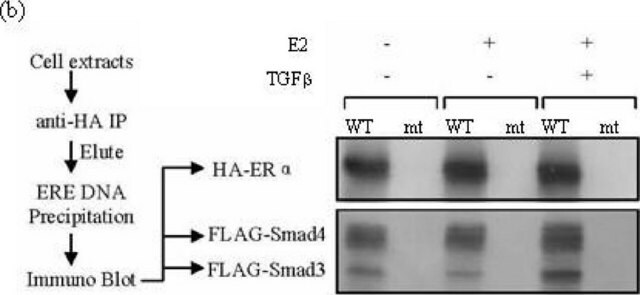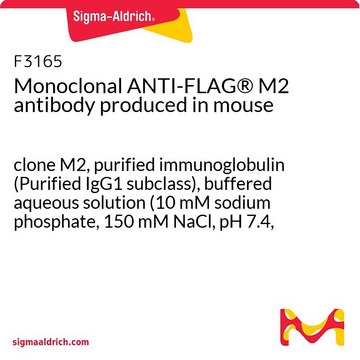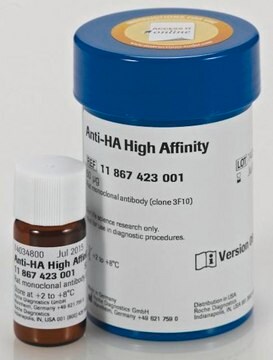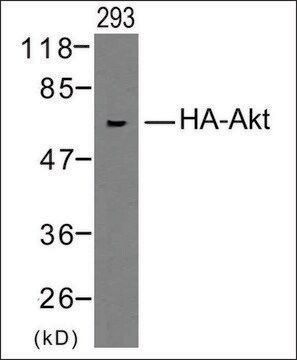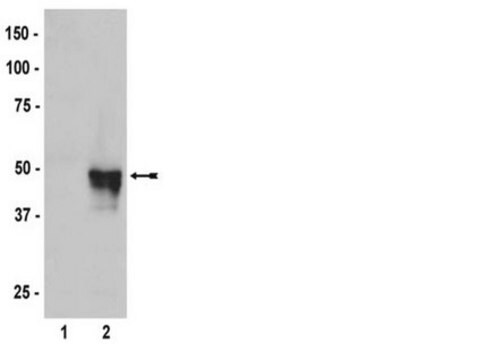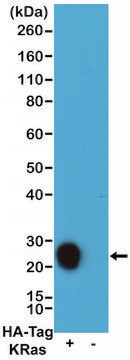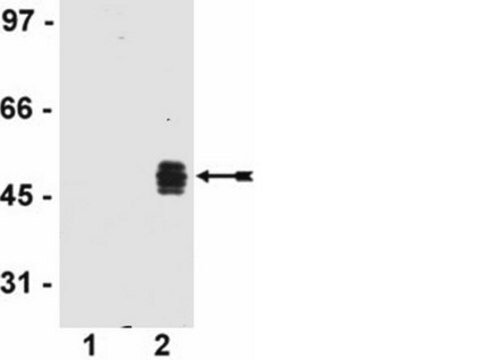추천 제품
생물학적 소스
rabbit
결합
unconjugated
항체 형태
affinity isolated antibody
항체 생산 유형
primary antibodies
클론
polyclonal
양식
buffered aqueous solution
기술
immunoprecipitation (IP): 2.5-4 μg/test using HA-tagged fusion protein from cell lysates
indirect immunofluorescence: 10-20 μg/mL using HA-tagged fusion protein transfected cells
western blot: 0.5-0.8 μg/mL using HA-tagged fusion protein transfected cell extracts
응용 분야
research pathology
배송 상태
dry ice
저장 온도
−20°C
타겟 번역 후 변형
unmodified
일반 설명
The hemagglutinin (HA) gene is mapped to segment 4 of Influenza B viral genome. HA is a dominant antigen present on the influenza viral surface. HA is a homotrimer, in which each monomer is produced as a single polypeptide. This monomer is cleaved into two subunits HA1 and HA2 by the host protease.
Influenza hemagglutinin protein is a nonapeptide derived from the major spike membrane glycoprotein of the human influenza virus. This strain specific glycoprotein is a homotrimer of 84 kDa monomers. Each monomers contain two disulfide-linked subunits: HA1 and HA2.
Anti-HA is produced in rabbit using a synthetic peptide corresponding to amino acid residues of the human Influenza hemagglutinin (HA), conjugated to KLH. The antibody is affinity-purified on the immobilized immunizing peptide.
Anti-HA antibody is specific for N- or C-terminal HA-tagged fusion proteins. The product may detect cross-reacting bands in certain mammalian cells. The immunizing HA peptide (Product No.I2149) specifically inhibits the staining of the HA-tagged protein band.
Influenza hemagglutinin protein is a nonapeptide derived from the major spike membrane glycoprotein of the human influenza virus. This strain specific glycoprotein is a homotrimer of 84 kDa monomers. Each monomers contain two disulfide-linked subunits: HA1 and HA2.
Anti-HA is produced in rabbit using a synthetic peptide corresponding to amino acid residues of the human Influenza hemagglutinin (HA), conjugated to KLH. The antibody is affinity-purified on the immobilized immunizing peptide.
Anti-HA antibody is specific for N- or C-terminal HA-tagged fusion proteins. The product may detect cross-reacting bands in certain mammalian cells. The immunizing HA peptide (Product No.I2149) specifically inhibits the staining of the HA-tagged protein band.
특이성
Anti-HA antibody is specific for N- or C-terminal HA-tagged fusion proteins.
The antibody reacts specifically with HA-tagged fusion proteins by immunoblotting and immunoprecipitation.
면역원
Synthetic peptide corresponding to amino acid residues of human Influenza virus hemagglutinin (HA) known as HA-tag, conjugated to KLH.
애플리케이션
Anti-HA antibody is suitable for use in immunoprecipitation and western blot.
It is also suitable for indirect immunofluorescence (10-20μg/mL using HA-tagged fusion protein transfected cells), immunoprecipitation (2.5-4μg/test using HA-tagged fusion protein from cell lysates), and western blot (0.5-0.8μg/mL using HA-tagged fusion protein transfected cell extracts).
It is also suitable for indirect immunofluorescence (10-20μg/mL using HA-tagged fusion protein transfected cells), immunoprecipitation (2.5-4μg/test using HA-tagged fusion protein from cell lysates), and western blot (0.5-0.8μg/mL using HA-tagged fusion protein transfected cell extracts).
생화학적/생리학적 작용
Hemagglutinin (HA) is an influenza-virus glycoprotein that regulates membrane fusion and receptor-binding functions during viral entry and infection. The virus gain entry into the host cell via endocytosis and successive membrane fusion mediated by the HA antigen. HA plays a crucial role in viral pathogenesis and host response to viral infection.
The HA gene is often used as an affinity tag for target proteins in recombinant expression vector systems. The HA-tagged proteins produced from such systems yield stable fusion products that do not interfere with the function and distribution of target proteins. Anti-HA antibody may detect cross-reacting bands in certain mammalian cells. The immunizing HA peptide (Product No.I2149) specifically inhibits the staining of the HA-tagged protein band. The nucleic acid sequence encoding the HA peptide has been incorporated into various expression plasmids adjacent to the cloning site thus enabling the cloning and expression of HA-tagged fusion protein. Such fusion proteins may be expressed in cells of various organisms: bacteria, yeast, insects and mammals. In the fusion protein, the HA sequence may serve as a recognition target for specific antibodies thus enabling detection, subcellular localization, characterization, quantification, functional analysis and affinity purification of the HA-tagged protein and associated bound proteins. Insertion of the HA epitope in different regions of a cellular protein followed by examination of the immunoreactivity of the epitope in intact and in permeabilized cells is useful for studying the cellular expression levels, topology and functional activity of the tagged protein. Antibody mediated detection of the HA tag obviates the need for time consuming generation of antibody specific for newly identified, low abundance, unstable, difficult to purify, cross-reactive or poorly immunogenic proteins.
The HA gene is often used as an affinity tag for target proteins in recombinant expression vector systems. The HA-tagged proteins produced from such systems yield stable fusion products that do not interfere with the function and distribution of target proteins. Anti-HA antibody may detect cross-reacting bands in certain mammalian cells. The immunizing HA peptide (Product No.I2149) specifically inhibits the staining of the HA-tagged protein band. The nucleic acid sequence encoding the HA peptide has been incorporated into various expression plasmids adjacent to the cloning site thus enabling the cloning and expression of HA-tagged fusion protein. Such fusion proteins may be expressed in cells of various organisms: bacteria, yeast, insects and mammals. In the fusion protein, the HA sequence may serve as a recognition target for specific antibodies thus enabling detection, subcellular localization, characterization, quantification, functional analysis and affinity purification of the HA-tagged protein and associated bound proteins. Insertion of the HA epitope in different regions of a cellular protein followed by examination of the immunoreactivity of the epitope in intact and in permeabilized cells is useful for studying the cellular expression levels, topology and functional activity of the tagged protein. Antibody mediated detection of the HA tag obviates the need for time consuming generation of antibody specific for newly identified, low abundance, unstable, difficult to purify, cross-reactive or poorly immunogenic proteins.
물리적 형태
Solution in 0.01 M phosphate buffered saline, pH 7.4, containing 1% bovine serum albumin and 15 mM sodium azide
저장 및 안정성
For continuous use, store at 2-8 °C for up to one month.
For extended storage freeze in working aliquots. Repeated freezing and thawing is not recommended. If slight turbidity occurs upon prolonged storage, clarify the solution by centrifugation before use. Solutions at working dilution should be discarded if not used within 12 hours.
For extended storage freeze in working aliquots. Repeated freezing and thawing is not recommended. If slight turbidity occurs upon prolonged storage, clarify the solution by centrifugation before use. Solutions at working dilution should be discarded if not used within 12 hours.
면책조항
Unless otherwise stated in our catalog or other company documentation accompanying the product(s), our products are intended for research use only and are not to be used for any other purpose, which includes but is not limited to, unauthorized commercial uses, in vitro diagnostic uses, ex vivo or in vivo therapeutic uses or any type of consumption or application to humans or animals.
적합한 제품을 찾을 수 없으신가요?
당사의 제품 선택기 도구.을(를) 시도해 보세요.
Storage Class Code
12 - Non Combustible Liquids
WGK
WGK 2
Flash Point (°F)
Not applicable
Flash Point (°C)
Not applicable
이미 열람한 고객
J J Skehel et al.
Annual review of biochemistry, 69, 531-569 (2000-08-31)
Hemagglutinin (HA) is the receptor-binding and membrane fusion glycoprotein of influenza virus and the target for infectivity-neutralizing antibodies. The structures of three conformations of the ectodomain of the 1968 Hong Kong influenza virus HA have been determined by X-ray crystallography:
Proline isomerase Pin1 represses terminal differentiation and myocyte enhancer factor 2C function in skeletal muscle cells.
Magli A, et al
The Journal of Biological Chemistry, jbc-M110 (2010)
Daniel Sanghoon Shin et al.
Blood, 116(24), 5162-5169 (2010-09-02)
The proton-coupled folate transporter (PCFT; SLC46A1) mediates folate transport into enterocytes in the proximal small intestine; pcft loss-of-function mutations are the basis for hereditary folate malabsorption. The current study explored the roles of Asp residues in PCFT function. A novel
Maarten Hoogenkamp et al.
Blood, 114(2), 299-309 (2009-04-03)
At the cellular level, development progresses through successive regulatory states, each characterized by their specific gene expression profile. However, the molecular mechanisms regulating first the priming and then maintenance of gene expression within one developmental pathway are essentially unknown. The
Functional evaluation of Dent?s disease-causing mutations: implications for ClC-5 channel trafficking and internalization.
Ludwig M, et al.
Human Genetics, 117(2-3), 228-237 (2005)
관련 콘텐츠
Protein and nucleic acid interaction reagents and resources for investing protein-RNA, protein-DNA, and protein-protein interactions and associated applications.
자사의 과학자팀은 생명 과학, 재료 과학, 화학 합성, 크로마토그래피, 분석 및 기타 많은 영역을 포함한 모든 과학 분야에 경험이 있습니다..
고객지원팀으로 연락바랍니다.
